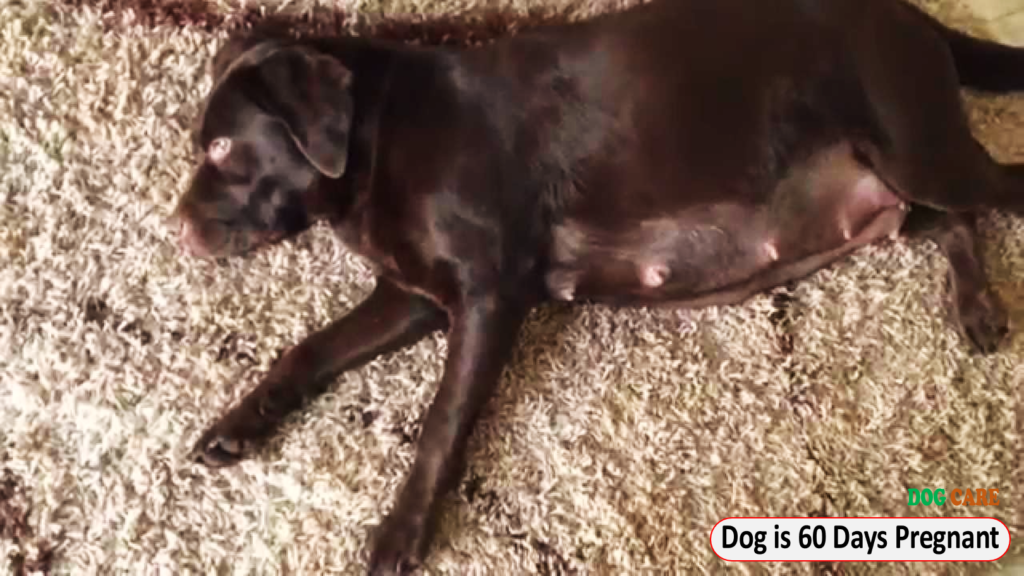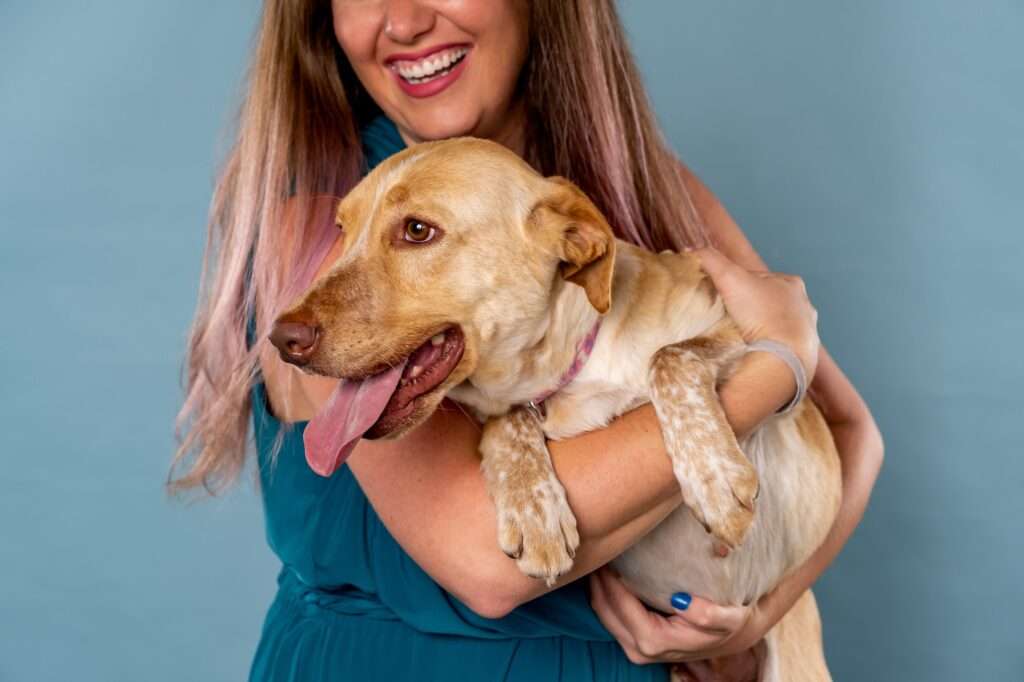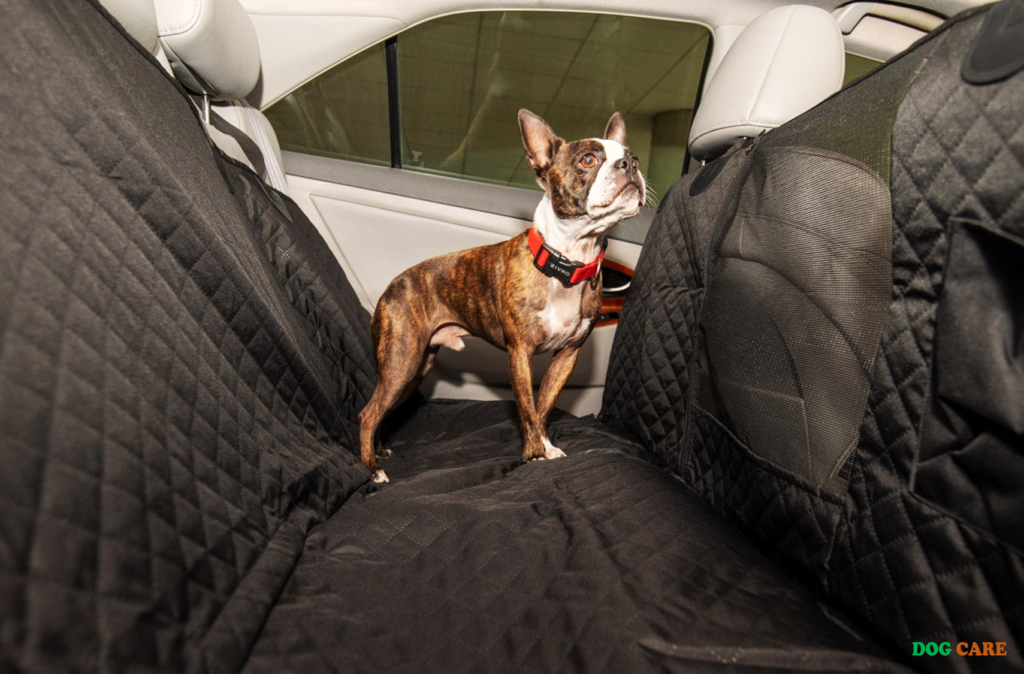My Dog is 60 Days Pregnant And Not Showing – If your dog is 60 days pregnant and not showing, it is advisable to consult a veterinarian for further evaluation. Pregnancy in dogs typically becomes noticeable from 21 to 35 days, with physical changes such as an enlarged abdomen, increased nipple size, and weight gain.
There can be various reasons why the pregnancy may not be apparent at this stage, including individual variations, stress, or the possibility of a false pregnancy. Professional examination and diagnostic tests can provide accurate information regarding your dog’s pregnancy status.
Prompt veterinary care can ensure the well-being of both the mother and her potential puppies.

Understanding Dog Pregnancy
At 60 days pregnant, it’s normal for a dog not to be showing visibly. Patience is key as development varies, and the puppies will become more noticeable in the coming weeks.
Understanding Dog Pregnancy When your furry companion is expecting, it can be an exciting and slightly nerve-wracking time. Just like human pregnancies, dog pregnancies come with their own set of physical changes and durations. If you notice that your dog is 60 days pregnant but not showing any visible signs, it’s important to understand the typical pregnancy duration for dogs and the physical changes that occur during this time.
Physical Changes During Dog Pregnancy
During a dog’s pregnancy, her body goes through a series of physical changes to prepare for the arrival of her puppies. These changes can vary from dog to dog, but there are some common signs to look out for. Here are some important physical changes that you may notice as your dog progresses through her pregnancy:
1. Enlarged Abdomen:
As the pregnancy progresses, you may start to notice your dog’s abdomen becoming larger and more rounded. This is a clear indication that her puppies are growing and developing inside her. However, it’s important to note that not all dogs show a significant increase in their abdomen size, especially if they have smaller litters or if they are carrying their puppies towards their back.
2. Weight Gain:
As your dog’s puppies grow, she will naturally gain weight. This weight gain can vary depending on the size, breed, and individual dog. It’s important to keep track of your dog’s weight throughout her pregnancy to ensure she’s gaining at a healthy rate. Consulting with your veterinarian can help you determine the ideal weight gain for your dog during each stage of pregnancy.
3. Nipple Development:
Another physical change you may notice is the development and enlargement of your dog’s nipples. As her body prepares for nursing, the nipples will become more prominent, and the surrounding area may become swollen. This is a natural part of the pregnancy process and is an indication that your dog is getting ready to feed her puppies.
Typical Pregnancy Duration For Dogs
Now that we’ve discussed some of the physical changes during a dog’s pregnancy, let’s look at the typical duration. It’s important to note that the duration can vary depending on several factors, including the breed of your dog. However, the average pregnancy duration for dogs is around 63 days. This duration is measured from the day of mating, not the day of conception. It’s important to keep in mind that individual dogs may have shorter or longer pregnancies.
Monitoring your dog’s behavior, physical changes, and consulting with your veterinarian can help you determine the expected duration for your specific dog’s pregnancy. During the pregnancy journey, it’s crucial to provide your dog with proper nutrition, regular veterinary check-ups, and a comfortable environment. By understanding the physical changes that occur and the typical duration of dog pregnancy, you’ll be better equipped to provide the care and support your furry friend needs during this special time.
Reasons For Not Showing Pregnancy
Your dog being 60 days pregnant with no visible signs of pregnancy can be puzzling and concerning. However, there are several factors that can contribute to this lack of visible pregnancy. Understanding these factors can help put your mind at ease and provide insight into your dog’s unique situation. In this article, we will explore the factors that contribute to the absence of visible pregnancy in your dog, as well as potential issues that may affect pregnancy appearance.
Factors That Contribute To Lack Of Visible Pregnancy
In some cases, it is perfectly normal for a pregnant dog not to show any visible signs of pregnancy during the first 60 days. Here are a few factors that can contribute to this:
- Litter size: The size of your dog’s litter plays a crucial role in determining when her pregnancy becomes apparent. Smaller litters may not cause as much abdominal distension, resulting in a less noticeable pregnancy.
- Breed: Different dog breeds have varying body structures, and this can affect how pregnancy shows. Some breeds naturally have more pronounced bellies while pregnant, whereas others may not show as much.
- Body condition: The physical condition of your dog can also impact how her pregnancy appears. If your dog is overweight or has a lot of abdominal fat, it may be harder to notice the pregnancy until later stages.
Potential Issues That May Affect Pregnancy Appearance
While it’s important to consider the factors mentioned above, there are also potential issues that could be affecting the visual signs of your dog’s pregnancy. These may require further investigation or veterinary attention, if necessary. Here are a few potential issues to be aware of:
| Issue | Description |
|---|---|
| Hormonal imbalance | In some cases, hormonal imbalances can disrupt the normal progression of pregnancy and hinder the visible signs. This could be due to various factors such as thyroid disorders or irregular reproductive hormone levels. |
| Intrauterine growth retardation | This condition refers to the abnormal growth of fetuses within the womb, leading to smaller and less visible pregnancies. It can occur due to genetic factors, poor nutrition, or other health conditions affecting the developing puppies. |
| Pseudopregnancy | In some cases, a dog may display signs of pregnancy even when not actually carrying a litter. This condition, known as pseudopregnancy, can mimic the physical symptoms of pregnancy without the presence of developing puppies. |
It is important to note that not all dogs follow the same timeline or exhibit the same physical changes during pregnancy. While your dog may not show visible signs of pregnancy at 60 days, it doesn’t necessarily indicate a problem. However, if you have any concerns or notice other abnormalities, consulting with your veterinarian is always recommended to ensure the health and well-being of your dog and her potential puppies.
Seeking Veterinary Advice
If your dog is 60 days pregnant and not showing, it is crucial to seek veterinary advice to ensure her health and the health of the puppies. Professional guidance is essential for monitoring the pregnancy and addressing any potential issues that may arise.
Importance Of Consulting A Veterinarian
When your dog is 60 days pregnant and not showing any physical signs, it can be concerning as an owner. While it’s natural to want to monitor your dog’s pregnancy on your own, seeking veterinary advice is crucial during this time. Consulting a veterinarian can provide you with the expertise and guidance needed to ensure the health and well-being of your pregnant dog and her developing puppies.
Below, we will explore the importance of consulting a veterinarian during your dog’s pregnancy and what you can expect during a veterinary check-up.
What To Expect During A Veterinary Check-up
During your dog’s pregnancy, regular veterinary check-ups are paramount. These check-ups not only allow the veterinarian to monitor your dog’s overall health but also provide you with peace of mind knowing that everything is progressing smoothly.
When you bring your pregnant dog to the veterinary clinic, here’s what you can expect:
- Physical Examination: The veterinarian will conduct a thorough physical examination, checking your dog’s weight, body condition, and vitals. They may palpate your dog’s abdomen to feel for any abnormalities and assess the size and position of the developing puppies.
- Ultrasound: Ultrasound is a key diagnostic tool during dog pregnancies. It allows the veterinarian to visualize the puppies in the uterus, confirming the presence of a viable pregnancy and assessing the fetal development. The veterinarian may also be able to estimate the number of puppies and determine their individual heartbeats.
- Blood Tests: Blood tests can provide valuable information about your dog’s overall health and can help identify any underlying conditions that may affect the pregnancy. These tests may include a complete blood count, blood chemistry panel, and hormone level analysis.
- Vaccinations and Deworming: The veterinarian will ensure that your dog’s vaccinations and deworming are up-to-date. This is important as it helps protect both the mother and the developing puppies from potential diseases.
- Nutritional Guidance: The veterinarian will discuss proper nutrition and feeding requirements during pregnancy. They may recommend a specific diet for your dog to support her and her growing puppies’ nutritional needs.
Remember, veterinary check-ups are not limited to just a single visit. Your veterinarian will likely schedule regular check-ups throughout your dog’s pregnancy to closely monitor her progress. These appointments are essential for detecting any potential complications early on and ensuring timely intervention if needed.
By seeking veterinary advice and following their professional guidance, you can confidently navigate your dog’s pregnancy journey, resulting in healthier puppies and a happier mother.

Diet And Exercise During Dog Pregnancy
If your dog is 60 days pregnant and not showing, you may wonder about the appropriate diet and exercise for her during this important phase. Proper nutrition and exercise are crucial to ensuring your dog has a healthy pregnancy and smooth delivery. In this section, we will discuss the importance of providing your pregnant dog with the right nutrients and safe exercises to keep her fit and strong.
Proper Nutrition For Pregnant Dogs
During pregnancy, your dog’s nutritional needs increase to support the growth and development of her puppies. It is important to provide balanced meals that contain all the essential nutrients she requires. Here are some key points to keep in mind when it comes to the diet of a pregnant dog:
- Increase in calorie intake: As your dog’s pregnancy progresses, she will need more calories to sustain her own body and support the growing puppies. It is recommended to gradually increase her food intake by 10-20% from the initial days of pregnancy.
- High-quality protein: Protein is essential for tissue development. Make sure to offer your pregnant dog high-quality protein sources, such as lean meats or specific dog foods formulated for pregnancy.
- Essential vitamins and minerals: Vitamins and minerals play a crucial role in the overall health and development of the puppies. Providing a nutritionally balanced diet, including a variety of fruits and vegetables, can help fulfill these requirements.
- Frequent, smaller meals: Instead of feeding large meals, divide your pregnant dog’s daily food portion into several smaller meals throughout the day. This can help with digestion and prevent discomfort.
- Offering fresh water: Ensure your dog has access to fresh and clean water at all times, as proper hydration is vital during pregnancy.
Safe And Recommended Exercises
Regular exercise is beneficial for pregnant dogs, as it helps maintain muscle tone, provide mental stimulation, and prevent excessive weight gain. However, it is crucial to choose exercises that are safe and appropriate for a dog in the later stages of pregnancy. Here are some exercises that you can consider for your pregnant dog:
- Gentle walks: Take your dog for short walks on a flat surface to promote circulation and maintain muscle tone. Avoid strenuous activities or long hikes that may put excessive strain on her body.
- Swimming: Swimming is a low-impact exercise that is gentle on the joints and provides a full-body workout. It can be a great option for pregnant dogs, but only if they are comfortable in the water and have been trained to swim.
- Puzzle toys and mental stimulation: Engaging your pregnant dog’s mind is just as important as physical exercise. Provide puzzle toys or activities that require problem-solving, which can help keep her mentally stimulated and active.
Remember, always consult with your veterinarian before implementing any changes to your dog’s diet or exercise routine. They can provide personalized recommendations based on your dog’s specific needs and health condition. By providing proper nutrition and safe exercise, you can ensure a healthy and enjoyable pregnancy for your dog and her puppies.
Complications And Warning Signs
In dog pregnancy, complications can arise, just like in any other pregnancy. It’s important for dog owners to be aware of these potential problems and familiarize themselves with the warning signs that indicate something may be wrong. In this blog post, we will discuss common complications during dog pregnancy and the signs that may indicate potential problems.
Common Complications During Dog Pregnancy
During dog pregnancy, there are several common complications that can occur. It’s essential for dog owners to be aware of these complications and take the necessary steps to ensure their dog’s health and safety. Here are some of the most common complications:
- Miscarriage: Miscarriages can occur during dog pregnancy, especially in the early stages. It is vital to recognize the signs of a miscarriage, such as vaginal bleeding, discharge, or sudden loss of appetite.
- Pyometra: Pyometra is a severe infection of the uterus that can occur in unspayed female dogs. This infection can be life-threatening and requires immediate veterinary attention. Some signs of pyometra include lethargy, excessive drinking, vomiting, and a distended abdomen.
- Premature Birth: Just like in human pregnancies, premature birth can happen in dogs too. It is essential to monitor the pregnancy closely and be prepared for the possibility of premature labor.
- Eclampsia: Also known as milk fever, eclampsia is a condition that can occur in the later stages of dog pregnancy. It is caused by low calcium levels and can lead to seizures, muscle tremors, and even death if left untreated.
These are just a few examples of common complications that can occur during dog pregnancy. It’s important for dog owners to be aware of these potential issues and seek veterinary assistance if any concerning symptoms arise.
Signs Indicating Potential Problems
While some complications can be more easily identified, there are also certain signs that may indicate potential problems. It is crucial for dog owners to pay close attention to their pregnant dog’s behavior and physical condition. Here are some signs that might indicate potential problems:
- Loss of Appetite: A significant decrease in appetite can be a sign of potential complications. If the pregnant dog refuses to eat or shows a sudden loss of interest in food, it’s advisable to seek veterinary guidance.
- Abnormal Discharge: Any abnormal vaginal discharge, such as a foul odor, excessive discharge, or blood, should be taken seriously and checked by a veterinarian.
- Excessive Lethargy: While pregnant dogs may naturally experience some fatigue, excessive lethargy or weakness can be a cause for concern.
- Abdominal Pain: If the dog shows signs of discomfort, whining, or restlessness, it may indicate abdominal pain and the need for immediate veterinary attention.
- Difficulty Breathing: Difficulty breathing, rapid breathing, or panting excessively can be a sign of distress and should be evaluated promptly.
Being aware of these signs and promptly addressing any concerns with a veterinarian can help mitigate potential complications and ensure the well-being of the pregnant dog and her puppies.
Preparing For Labor And Delivery
Preparing for labor and delivery is an important part of welcoming new puppies into the world. As your dog reaches the 60-day mark in her pregnancy, it’s crucial to create a comfortable birthing environment and be alert to the signs of labor. In this section, we will discuss the steps you can take to ensure a smooth and safe delivery for your expecting dog.
Creating A Comfortable Birthing Environment
When the time comes for your dog to give birth, it’s essential to provide her with a comfortable and safe space. Here are a few steps you can take to create a suitable birthing environment:
- Select a quiet and secluded area: Choose a room or corner in your home where your dog can have some privacy and feel secure. This will help reduce any stress or anxiety she may be feeling, leading to a smoother labor process.
- Prepare a whelping box: A whelping box is a specially designed box or area where your dog can give birth and nurse her puppies. It should be large enough for her to move around comfortably and have high enough walls to prevent the puppies from crawling out. Line the box with clean towels or blankets for warmth and easy cleaning.
- Maintain a clean and hygienic area: Regularly clean the whelping box to ensure a healthy and sterile environment for both your dog and the newborn puppies. This helps minimize the risk of infections and keeps the space comfortable.
Recognizing Labor Signs
As your dog nears her due date, it’s crucial to be able to recognize the signs of labor. This will give you ample time to prepare and provide the necessary assistance. Here are some common signs that indicate your dog is going into labor:
- Nesting behavior: Your dog may start to show nesting behavior, such as making a nest out of blankets or trying to find a secluded spot to give birth.
- Temperature drop: Taking your dog’s temperature rectally can help you anticipate labor. A drop in temperature below 100°F is usually an indication that labor will begin within the next 24 hours.
- Restlessness and pacing: Your dog may become restless and start pacing around as labor approaches. She may also pant excessively and exhibit signs of discomfort.
- Visible contractions: During active labor, your dog will have visible contractions. These contractions will become stronger and more frequent as the delivery progresses.
- Breaking of water: Just before a puppy is born, the amniotic sac will rupture, releasing fluid. This is commonly known as the “water breaking” and is a sign that delivery is imminent.
By paying close attention to these signs, you can be prepared for the arrival of the puppies and provide the necessary support during the labor process.
Postpartum Care And Puppy Development
At 60 days pregnant, it’s common for a dog not to show physical signs of pregnancy. Postpartum care and puppy development are important aspects to consider during this stage.
After 60 days of eagerly waiting, it’s finally time for your dog to bring new life into the world. As a responsible pet owner, it’s essential to understand the importance of postpartum care and puppy development during this exciting time. This article will provide valuable insights into caring for the new mother and monitoring and nurturing the puppies.
Caring For The New Mother
The postpartum period is a critical time for the mother dog, as she needs to recover from the labor and adjust to her new role as a mother. Here are some essential tips to help you provide the care and support she needs:
- Provide a calm and comfortable environment: Create a quiet and secluded space where the mother dog can relax and bond with her puppies. Avoid excessive noise or disruptions that may cause stress.
- Monitor her health: Keep a close eye on the mother’s health during the postpartum period. Look out for any signs of complications or discomfort, such as excessive bleeding, lethargy, or loss of appetite. If you notice anything unusual, consult a veterinarian right away.
- Ensure proper nutrition: A nursing mother dog requires a balanced and nutritious diet to produce adequate milk for her puppies. Consult your vet for guidance on the appropriate food and feeding schedule for the new mother.
- Promote cleanliness: Maintain a clean environment for the mother and her puppies. Regularly clean their bedding and ensure proper hygiene to prevent the risk of infections.
- Provide bonding time: Allow the mother dog to spend quality time with her puppies to establish strong maternal bonds. Monitor their interactions to ensure the mother is nurturing and caring for her litter effectively.
Monitoring And Nurturing The Puppies
While caring for the new mother is crucial, equally important is monitoring and nurturing the puppies’ development. Here’s what you need to know about their growth and well-being:
- Observe weight gain: Regularly monitor the puppies’ weight to ensure they are gaining at a healthy rate. Weight gain is a positive sign of adequate nutrition and overall well-being.
- Encourage socialization: As the puppies grow, introduce them to different sights, sounds, and experiences. This exposure helps them develop confidence and adaptability as they mature.
- Support their early development: Puppies are born with closed eyes and ears, so it’s crucial to provide a safe and warm environment. Take care in handling them gently, ensuring they have proper nursing time and regular visits to the veterinarian for check-ups and vaccinations.
- Monitor for any abnormalities: Watch for any signs of illness or developmental issues, such as difficulty nursing, unusual lethargy, abnormal stool, or failure to thrive. It’s important to consult a vet if you notice anything concerning.
- Enjoy the journey: This is an incredible time for you as a pet owner, watching your puppies grow and develop into playful companions. Cherish each moment and provide them with the love, care, and attention they need to thrive.
Caring for the new mother and nurturing the puppies during the postpartum period requires vigilance, patience, and love. By following these tips and closely monitoring their progress, you can ensure a healthy and happy start for the mother and her precious little ones.
Frequently Asked Questions For My Dog Is 60 Days Pregnant And Not Showing
How Long Does It Take For A Dog To Show Signs Of Pregnancy?
A dog typically starts showing signs of pregnancy around 21 to 35 days after mating.
Is It Normal For A Dog Not To Show When Pregnant?
Yes, it is normal for a dog not to show when pregnant, especially during the first few weeks.
Why Is My Dog Not Showing Signs Of Pregnancy?
There could be various reasons why your dog is not showing signs of pregnancy, such as a small litter size or slower development.
Can A Pregnant Dog Still Play And Be Active?
Yes, pregnant dogs can still play and be active, but it’s essential to ensure they don’t overexert themselves.
Should I Be Worried If My Pregnant Dog Is Not Gaining Weight?
It is not uncommon for some pregnant dogs not to gain much weight, but it’s best to consult with a veterinarian to ensure everything is okay.
When Should I Start Preparing For My Dog’s Pregnancy?
It’s best to start preparing for your dog’s pregnancy at least a few weeks before her expected due date.
What Should I Do If My Pregnant Dog Is Not Eating?
If your pregnant dog is not eating, it’s crucial to consult with a veterinarian, as loss of appetite can be a sign of underlying issues.
Conclusion
It’s not uncommon for pregnant dogs to not show signs until later in their pregnancy. While it may be worrisome, it’s important to remember that each dog is different. Staying informed about the gestation period, taking care of her health, and consulting your vet will ensure a safe and healthy pregnancy for your fur baby.
Embrace this exciting time and cherish the journey with your four-legged companion.


